Author: Vitalik Buterin via the Vitalik Buterin Blog
Special thanks to the Worldcoin and Modulus Labs teams, Xinyuan Sun, Martin Koeppelmann and Illia Polosukhin for feedback and discussion.
Many people over the years have asked me a similar question: what are the intersections between crypto and AI that I consider to be the most fruitful? It’s a reasonable question: crypto and AI are the two main deep (software) technology trends of the past decade, and it just feels like there must be some kind of connection between the two. It’s easy to come up with synergies at a superficial vibe level: crypto decentralization can balance out AI centralization, AI is opaque and crypto brings transparency, AI needs data and blockchains are good for storing and tracking data. But over the years, when people would ask me to dig a level deeper and talk about specific applications, my response has been a disappointing one: “yeah there’s a few things but not that much”.
In the last three years, with the rise of much more powerful AI in the form of modern LLMs, and the rise of much more powerful crypto in the form of not just blockchain scaling solutions but also ZKPs, FHE, (two-party and N-party) MPC, I am starting to see this change. There are indeed some promising applications of AI inside of blockchain ecosystems, or AI together with cryptography, though it is important to be careful about how the AI is applied. A particular challenge is: in cryptography, open source is the only way to make something truly secure, but in AI, a model (or even its training data) being open greatly increases its vulnerability to adversarial machine learning attacks. This post will go through a classification of different ways that crypto + AI could intersect, and the prospects and challenges of each category.
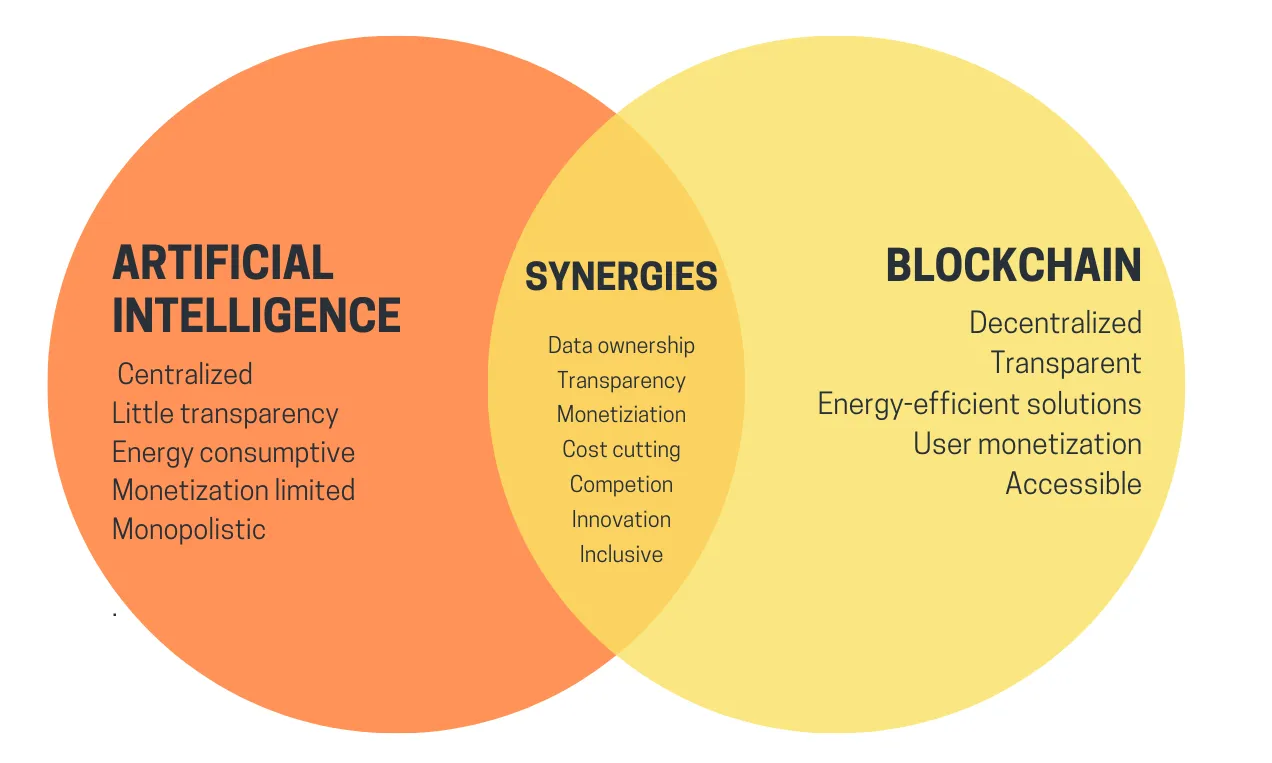
A high-level summary of crypto+AI intersections from a uETH blog post. But what does it take to actually realize any of these synergies in a concrete application?
The four major categories
AI is a very broad concept: you can think of “AI” as being the set of algorithms that you create not by specifying them explicitly, but rather by stirring a big computational soup and putting in some kind of optimization pressure that nudges the soup toward producing algorithms with the properties that you want. This description should definitely not be taken dismissively: it includes the process that created us humans in the first place! But it does mean that AI algorithms have some common properties: their ability to do things that are extremely powerful, together with limits in our ability to know or understand what’s going on under the hood.
There are many ways to categorize AI; for the purposes of this post, which talks about interactions between AI and blockchains (which have been described as a platform for creating “games”), I will categorize it as follows:
- AI as a player in a game [highest viability]: AIs participating in mechanisms where the ultimate source of the incentives comes from a protocol with human inputs.
- AI as an interface to the game [high potential, but with risks]: AIs helping users to understand the crypto world around them, and to ensure that their behavior (ie. signed messages and transactions) matches their intentions and they do not get tricked or scammed.
- AI as the rules of the game [tread very carefully]: blockchains, DAOs and similar mechanisms directly calling into AIs. Think eg. “AI judges”
- AI as the objective of the game [longer-term but intriguing]: designing blockchains, DAOs and similar mechanisms with the goal of constructing and maintaining an AI that could be used for other purposes, using the crypto bits either to better incentivize training or to prevent the AI from leaking privacte data or being misused.
Let us go through these one by one.
AI as a player in a game
This is actually a category that has existed for nearly a decade, at least since on-chain decentralized exchanges (DEXes) started to see significant use. Any time there is an exchange, there is an opportunity to make money through arbitrage, and bots can do arbitrage much better than humans can. This use case has existed for a long time, even with much simpler AIs than what we have today, but ultimately it is a very real AI + crypto intersection. More recently, we have seen MEV arbitrage bots often exploiting each other. Any time you have a blockchain application that involves auctions or trading, you are going to have arbitrage bots.
But AI arbitrage bots are only the first example of a much bigger category, which I expect will soon start to include many other applications. Meet AIOmen, a demo of a prediction market where AIs are players:
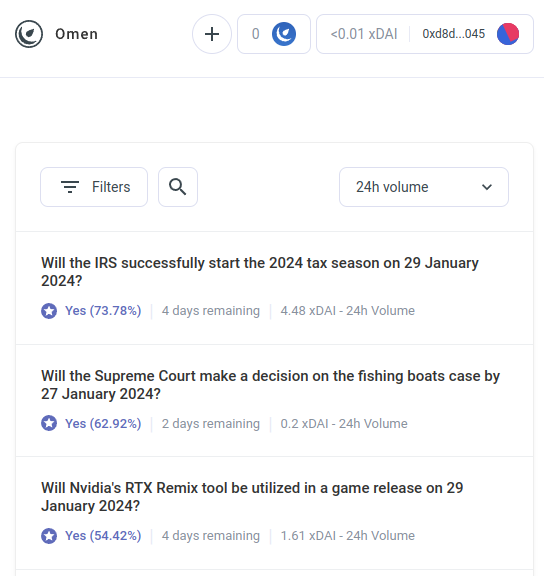
One response to this is to point to ongoing UX improvements in Polymarket or other new prediction markets, and hope that they will succeed where previous iterations have failed. After all, the story goes, people are willing to bet tens of billions on sports, so why wouldn’t people throw in enough money betting on US elections or LK99 that it starts to make sense for the serious players to start coming in? But this argument must contend with the fact that, well, previous iterations have failed to get to this level of scale (at least compared to their proponents’ dreams), and so it seems like you need something new to make prediction markets succeed. And so a different response is to point to one specific feature of prediction market ecosystems that we can expect to see in the 2020s that we did not see in the 2010s: the possibility of ubiquitous participation by AIs.
AIs are willing to work for less than $1 per hour, and have the knowledge of an encyclopedia – and if that’s not enough, they can even be integrated with real-time web search capability. If you make a market, and put up a liquidity subsidy of $50, humans will not care enough to bid, but thousands of AIs will easily swarm all over the question and make the best guess they can. The incentive to do a good job on any one question may be tiny, but the incentive to make an AI that makes good predictions in general may be in the millions. Note that potentially, you don’t even need the humans to adjudicate most questions: you can use a multi-round dispute system similar to Augur or Kleros, where AIs would also be the ones participating in earlier rounds. Humans would only need to respond in those few cases where a series of escalations have taken place and large amounts of money have been committed by both sides.
This is a powerful primitive, because once a “prediction market” can be made to work on such a microscopic scale, you can reuse the “prediction market” primitive for many other kinds of questions:
- Is this social media post acceptable under [terms of use]?
- What will happen to the price of stock X (eg. see Numerai)
- Is this account that is currently messaging me actually Elon Musk?
- Is this work submission on an online task marketplace acceptable?
- Is the dapp at https://examplefinance.network a scam?
- Is
0x1b54....98c3actually the address of the “Casinu Inu” ERC20 token?
You may notice that a lot of these ideas go in the direction of what I called “info defense” in . Broadly defined, the question is: how do we help users tell apart true and false information and detect scams, without empowering a centralized authority to decide right and wrong who might then abuse that position? At a micro level, the answer can be “AI”. But at a macro level, the question is: who builds the AI? AI is a reflection of the process that created it, and so cannot avoid having biases. Hence, there is a need for a higher-level game which adjudicates how well the different AIs are doing, where AIs can participate as players in the game.
This usage of AI, where AIs participate in a mechanism where they get ultimately rewarded or penalized (probabilistically) by an on-chain mechanism that gathers inputs from humans (call it decentralized market-based RLHF?), is something that I think is really worth looking into. Now is the right time to look into use cases like this more, because blockchain scaling is finally succeeding, making “micro-” anything finally viable on-chain when it was often not before.
A related category of applications goes in the direction of highly autonomous agents using blockchains to better cooperate, whether through payments or through using smart contracts to make credible commitments.
AI as an interface to the game
One idea that I brought up in my writings on is the idea that there is a market opportunity to write user-facing software that would protect users’ interests by interpreting and identifying dangers in the online world that the user is navigating. One already-existing example of this is Metamask’s scam detection feature:


Potentially, these kinds of tools could be super-charged with AI. AI could give a much richer human-friendly explanation of what kind of dapp you are participating in, the consequences of more complicated operations that you are signing, whether or not a particular token is genuine (eg. BITCOIN is not just a string of characters, it’s the name of an actual cryptocurrency, which is not an ERC20 token and which has a price waaaay higher than $0.045, and a modern LLM would know that), and so on. There are projects starting to go all the way out in this direction (eg. the LangChain wallet, which uses AI as a primary interface). My own opinion is that pure AI interfaces are probably too risky at the moment as it increases the risk of other kinds of errors, but AI complementing a more conventional interface is getting very viable.
There is one particular risk worth mentioning. I will get into this more in the section on “AI as rules of the game” below, but the general issue is adversarial machine learning: if a user has access to an AI assistant inside an open-source wallet, the bad guys will have access to that AI assistant too, and so they will have unlimited opportunity to optimize their scams to not trigger that wallet’s defenses. All modern AIs have bugs somewhere, and it’s not too hard for a training process, even one with only limited access to the model, to find them.
This is where “AIs participating in on-chain micro-markets” works better: each individual AI is vulnerable to the same risks, but you’re intentionally creating an open ecosystem of dozens of people constantly iterating and improving them on an ongoing basis. Furthermore, each individual AI is closed: the security of the system comes from the openness of the rules of the game, not the internal workings of each player.
Summary: AI can help users understand what’s going on in plain language, it can serve as a real-time tutor, it can protect users from mistakes, but be warned when trying to use it directly against malicious misinformers and scammers.
AI as the rules of the game
Now, we get to the application that a lot of people are excited about, but that I think is the most risky, and where we need to tread the most carefully: what I call AIs being part of the rules of the game. This ties into excitement among mainstream political elites about “AI judges” (eg. see this article on the website of the “World Government Summit”), and there are analogs of these desires in blockchain applications. If a blockchain-based smart contract or a DAO needs to make a subjective decision (eg. is a particular work product acceptable in a work-for-hire contract? Which is the right interpretation of a natural-language constitution like the Optimism Law of Chains?), could you make an AI simply be part of the contract or DAO to help enforce these rules?
This is where adversarial machine learning is going to be an extremely tough challenge. The basic two-sentence argument why is as follows:
If an AI model that plays a key role in a mechanism is closed, you can’t verify its inner workings, and so it’s no better than a centralized application. If the AI model is open, then an attacker can download and simulate it locally, and design heavily optimized attacks to trick the model, which they can then replay on the live network.

Now, frequent readers of this blog (or denizens of the cryptoverse) might be getting ahead of me already, and thinking: but wait! We have fancy zero knowledge proofs and other really cool forms of cryptography. Surely we can do some crypto-magic, and hide the inner workings of the model so that attackers can’t optimize attacks, but at the same time prove that the model is being executed correctly, and was constructed using a reasonable training process on a reasonable set of underlying data!
Normally, this is exactly the type of thinking that I advocate both on this blog and in my other writings. But in the case of AI-related computation, there are two major objections:
- Cryptographic overhead: it’s much less efficient to do something inside a SNARK (or MPC or…) than it is to do it “in the clear”. Given that AI is very computationally-intensive already, is doing AI inside of cryptographic black boxes even computationally viable?
- Black-box adversarial machine learning attacks: there are ways to optimize attacks against AI models even without knowing much about the model’s internal workings. And if you hide too much, you risk making it too easy for whoever chooses the training data to corrupt the model with poisoning attacks.
Both of these are complicated rabbit holes, so let us get into each of them in turn.
Cryptographic overhead
Cryptographic gadgets, especially general-purpose ones like ZK-SNARKs and MPC, have a high overhead. An Ethereum block takes a few hundred milliseconds for a client to verify directly, but generating a ZK-SNARK to prove the correctness of such a block can take hours. The typical overhead of other cryptographic gadgets, like MPC, can be even worse. AI computation is expensive already: the most powerful LLMs can output individual words only a little bit faster than human beings can read them, not to mention the often multimillion-dollar computational costs of training the models. The difference in quality between top-tier models and the models that try to economize much more on training cost or parameter count is large. At first glance, this is a very good reason to be suspicious of the whole project of trying to add guarantees to AI by wrapping it in cryptography.
Fortunately, though, AI is a very specific type of computation, which makes it amenable to all kinds of optimizations that more “unstructured” types of computation like ZK-EVMs cannot benefit from. Let us examine the basic structure of an AI model:
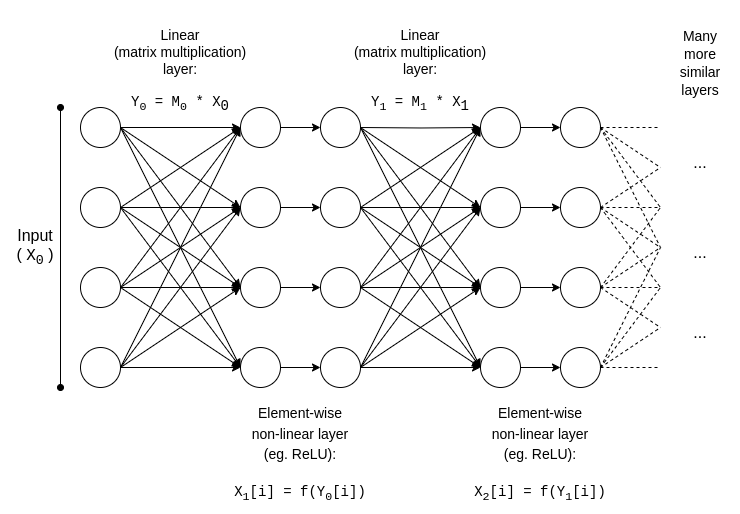
y = max(x, 0)). Asymptotically, matrix multiplications take up most of the work: multiplying two N*N matrices takes �(�2.8) time, whereas the number of non-linear operations is much smaller. This is really convenient for cryptography, because many forms of cryptography can do linear operations (which matrix multiplications are, at least if you encrypt the model but not the inputs to it) almost “for free”.
If you are a cryptographer, you’ve probably already heard of a similar phenomenon in the context of homomorphic encryption: performing additions on encrypted ciphertexts is really easy, but multiplications are incredibly hard and we did not figure out any way of doing it at all with unlimited depth until 2009.
For ZK-SNARKs, the equivalent is protocols like this one from 2013, which show a less than 4x overhead on proving matrix multiplications. Unfortunately, the overhead on the non-linear layers still ends up being significant, and the best implementations in practice show overhead of around 200x. But there is hope that this can be greatly decreased through further research; see this presentation from Ryan Cao for a recent approach based on GKR, and my own simplified explanation of how the main component of GKR works.
But for many applications, we don’t just want to prove that an AI output was computed correctly, we also want to hide the model. There are naive approaches to this: you can split up the model so that a different set of servers redundantly store each layer, and hope that some of the servers leaking some of the layers doesn’t leak too much data. But there are also surprisingly effective forms of specialized multi-party computation.
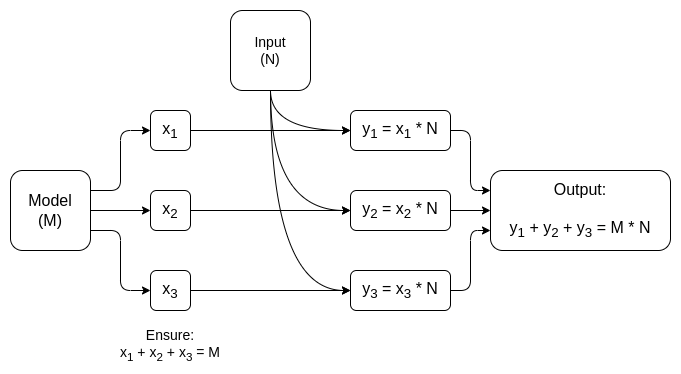
In both cases, the moral of the story is the same: the greatest part of an AI computation is matrix multiplications, for which it is possible to make very efficient ZK-SNARKs or MPCs (or even FHE), and so the total overhead of putting AI inside cryptographic boxes is surprisingly low. Generally, it’s the non-linear layers that are the greatest bottleneck despite their smaller size; perhaps newer techniques like lookup arguments can help.
Black-box adversarial machine learning
Now, let us get to the other big problem: the kinds of attacks that you can do even if the contents of the model are kept private and you only have “API access” to the model. Quoting a paper from 2016:
Many machine learning models are vulnerable to adversarial examples: inputs that are specially crafted to cause a machine learning model to produce an incorrect output. Adversarial examples that affect one model often affect another model, even if the two models have different architectures or were trained on different training sets, so long as both models were trained to perform the same task. An attacker may therefore train their own substitute model, craft adversarial examples against the substitute, and transfer them to a victim model, with very little information about the victim.
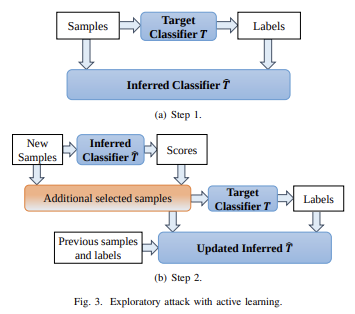
Potentially, you can even create attacks knowing just the training data, even if you have very limited or no access to the model that you are trying to attack. As of 2023, these kinds of attacks continue to be a large problem.
To effectively curtail these kinds of black-box attacks, we need to do two things:
- Really limit who or what can query the model and how much. Black boxes with unrestricted API access are not secure; black boxes with very restricted API access may be.
- Hide the training data, while preserving confidence that the process used to create the training data is not corrupted.
The project that has done the most on the former is perhaps Worldcoin, of which I analyze an earlier version (among other protocols) at length here. Worldcoin uses AI models extensively at protocol level, to (i) convert iris scans into short “iris codes” that are easy to compare for similarity, and (ii) verify that the thing it’s scanning is actually a human being. The main defense that Worldcoin is relying on is the fact that it’s not letting anyone simply call into the AI model: rather, it’s using trusted hardware to ensure that the model only accepts inputs digitally signed by the orb’s camera.
This approach is not guaranteed to work: it turns out that you can make adversarial attacks against biometric AI that come in the form of physical patches or jewelry that you can put on your face:

But the hope is that if you combine all the defenses together, hiding the AI model itself, greatly limiting the number of queries, and requiring each query to somehow be authenticated, you can adversarial attacks difficult enough that the system could be secure.
And this gets us to the second part: how can we hide the training data? This is where “DAOs to democratically govern AI” might actually make sense: we can create an on-chain DAO that governs the process of who is allowed to submit training data (and what attestations are required on the data itself), who is allowed to make queries, and how many, and use cryptographic techniques like MPC to encrypt the entire pipeline of creating and running the AI from each individual user’s training input all the way to the final output of each query. This DAO could simultaneously satisfy the highly popular objective of compensating people for submitting data.
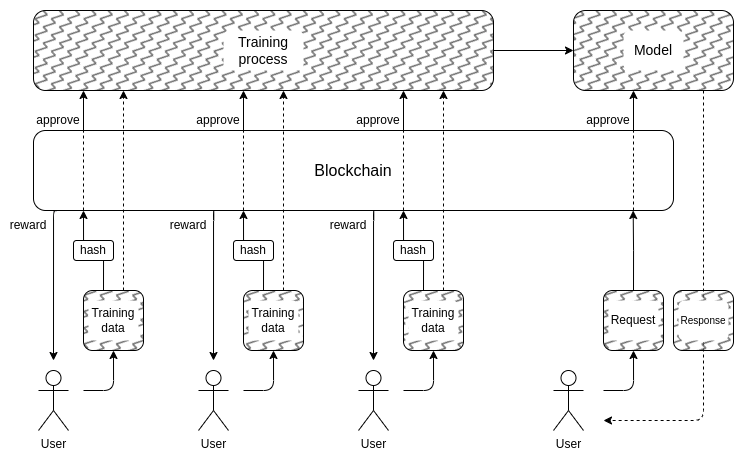
- Cryptographic overhead could still turn out too high for this kind of fully-black-box architecture to be competitive with traditional closed “trust me” approaches.
- It could turn out that there isn’t a good way to make the training data submission process decentralized and protected against poisoning attacks.
- Multi-party computation gadgets could break their safety or privacy guarantees due to participants colluding: after all, this has happened with cross-chain cryptocurrency bridges again and again.
One reason why I didn’t start this section with more big red warning labels saying “DON’T DO AI JUDGES, THAT’S DYSTOPIAN”, is that our society is highly dependent on unaccountable centralized AI judges already: the algorithms that determine which kinds of posts and political opinions get boosted and deboosted, or even censored, on social media. I do think that expanding this trend further at this stage is quite a bad idea, but I don’t think there is a large chance that the blockchain community experimenting with AIs more will be the thing that contributes to making it worse.
In fact, there are some pretty basic low-risk ways that crypto technology can make even these existing centralized systems better that I am pretty confident in. One simple technique is verified AI with delayed publication: when a social media site makes an AI-based ranking of posts, it could publish a ZK-SNARK proving the hash of the model that generated that ranking. The site could commit to revealing its AI models after eg. a one year delay. Once a model is revealed, users could check the hash to verify that the correct model was released, and the community could run tests on the model to verify its fairness. The publication delay would ensure that by the time the model is revealed, it is already outdated.
So compared to the centralized world, the question is not if we can do better, but by how much. For the decentralized world, however, it is important to be careful: if someone builds eg. a prediction market or a stablecoin that uses an AI oracle, and it turns out that the oracle is attackable, that’s a huge amount of money that could disappear in an instant.
AI as the objective of the game
If the above techniques for creating a scalable decentralized private AI, whose contents are a black box not known by anyone, can actually work, then this could also be used to create AIs with utility going beyond blockchains. The NEAR protocol team is making this a core objective of their ongoing work.
There are two reasons to do this:
- If you can make “trustworthy black-box AIs” by running the training and inference process using some combination of blockchains and MPC, then lots of applications where users are worried about the system being biased or cheating them could benefit from it. Many people have expressed a desire for democratic governance of systemically-important AIs that we will depend on; cryptographic and blockchain-based techniques could be a path toward doing that.
- From an AI safety perspective, this would be a technique to create a decentralized AI that also has a natural kill switch, and which could limit queries that seek to use the AI for malicious behavior.
It is also worth noting that “using crypto incentives to incentivize making better AI” can be done without also going down the full rabbit hole of using cryptography to completely encrypt it: approaches like BitTensor fall into this category.
Conclusions
Now that both blockchains and AIs are becoming more powerful, there is a growing number of use cases in the intersection of the two areas. However, some of these use cases make much more sense and are much more robust than others. In general, use cases where the underlying mechanism continues to be designed roughly as before, but the individual players become AIs, allowing the mechanism to effectively operate at a much more micro scale, are the most immediately promising and the easiest to get right.
The most challenging to get right are applications that attempt to use blockchains and cryptographic techniques to create a “singleton”: a single decentralized trusted AI that some application would rely on for some purpose. These applications have promise, both for functionality and for improving AI safety in a way that avoids the centralization risks associated with more mainstream approaches to that problem. But there are also many ways in which the underlying assumptions could fail; hence, it is worth treading carefully, especially when deploying these applications in high-value and high-risk contexts.
I look forward to seeing more attempts at constructive use cases of AI in all of these areas, so we can see which of them are truly viable at scale.
Author: Vitalik Buterin
- SEO Powered Content & PR Distribution. Get Amplified Today.
- PlatoData.Network Vertical Generative Ai. Empower Yourself. Access Here.
- PlatoAiStream. Web3 Intelligence. Knowledge Amplified. Access Here.
- PlatoESG. Carbon, CleanTech, Energy, Environment, Solar, Waste Management. Access Here.
- PlatoHealth. Biotech and Clinical Trials Intelligence. Access Here.
- BlockOffsets. Modernizing Environmental Offset Ownership. Access Here.
- Source: Plato Data Intelligence.
<p>The post The promise and challenges of crypto + AI applications first appeared on Plato AiStream V2.1.</p>